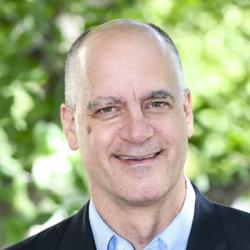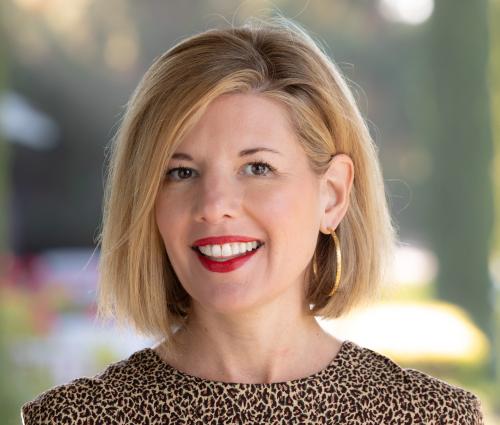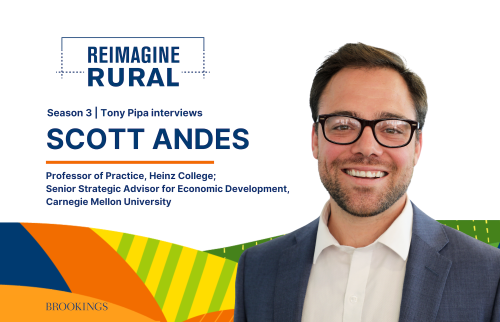In the latest episode of the Reimagine Rural podcast, Tony Pipa travels to Beardstown, Illinois—where over a couple of decades, immigrants have helped revive a river town once on the brink—to explore what rapid demographic change means for small-town life. In this conversation with Rachel Perić of Welcoming America, they discuss the factors that lead immigrants to rural places, the benefits and challenges that follow, and how shifting federal policies ripple through local relationships, trust, and governance. They also consider what practical steps can help communities leverage this change for shared prosperity.
This conversation has been lightly edited for clarity and brevity.
Tony Pipa (TP): Tell us about the mission of Welcoming America.
Rachel Perić (RP): Welcoming America is all about building a nation of neighbors. Our work is focused on supporting people in communities who want to make sure that the places they live are ones where everyone can belong and thrive together, whether we’ve just arrived or have been in a community for generations. We support people who are doing that work through a network of communities and ones certified as welcoming places, as well as a host of other activities.
Our work came out of rural places. The original welcoming efforts that led to us coming into existence in 2009 started in places like Tennessee and Iowa, small towns that were experiencing really rapid demographic change in the early 2000s. Like Beardstown, they were thinking about what that meant for their communities and how they could create an environment where everyone felt at home.
She found the U.S. to be a beacon of safety and opportunity, as so many immigrants today do.
Rachel Perić
TP: What led you personally to this work?
RP: My family, like many families in this country, came as immigrants. My mom and my grandparents arrived as refugees in the late 1940s. My grandmother ultimately opened a small business in a mid-sized town in a farming community, and hers was one of the millions of immigrant businesses that saved a dying main street. She had come from a rural place and really felt at home in Frederick (Maryland), which was important since she had left a place where her identity as a Holocaust survivor meant that she no longer felt safe.
She found the U.S. to be a beacon of safety and opportunity, as so many immigrants today do. That is a great legacy that I get to carry on through my work at Welcoming America—to not only support people like my grandmother, but live into this promise that we hold as Americans, that you can come from anywhere in the world and call yourself an American.
TP: In this episode, we hear about Beardstown experiencing a lot of rapid demographic change through immigration, and how those immigrants have helped revitalize the town. From what you’ve seen, what does immigration mean for small towns, which are often struggling with population loss, especially the loss of youth and talent?
RP: Zooming out to the macro picture, there’s data showing that roughly 70% of rural places have seen declining populations since the 1990s. Of those, nearly four out of five would have seen further decline if not for immigration. So, attracting and keeping people in a community through immigration is existential. It’s not just about getting people into a community. We want people to be rooted in a place. We want people to know that they belong, to be able to raise a family, to be able to thrive alongside their neighbors.
We support a network of communities around the U.S., a quarter of which are rural places. And we work with many places around the country who are going through demographic changes, much like Beardstown, and trying to find practical ways to make the most of that. I think it is an untold story that there are so many rural places that are beacons the country can look to, especially now, in terms of how we can create communities that are healthy, economically vital, and welcoming.
TP: But the stereotype of many small towns is that it can take decades or even a generation or two until residents will consider someone “from here.” What practical steps help communities become genuinely welcoming?
RP: What is so universal in the Beardstown story is the set of different reactions that happen as a community has a growing immigrant population. Oftentimes, there’s this unease and tension that sets in as people are trying to get to know each other—both from the perspective of the new person arriving and feeling like an outsider, and also from the perspective of a community trying to make sense of this change.
That speaks to a need for leadership, whether a mayor or a pastor or somebody else, being able to grab hold of narratives before they start to stereotype people and say, “We’re going to have to focus more on how we connect as neighbors.”
A lot of communities that we’ve worked with put a lot of effort into making sure that leaders are active in that role. It’s so easy for misconceptions, stereotypes, and fear to set in. That’s a real opportunity for leaders, both immigrant and non-immigrant, and institutions in the community impacted by demographic change, to come together and create a plan: “What will it mean for our institutions to make sure everyone is able to participate, to learn English, to access opportunities in this community?”
We have all seen how conflict entrepreneurs will seize on these moments of growth in immigrant communities to try to stir the pot. It’s important for leaders to get ahead and call that out, because there’s real fear and harm that gets created, much of it being generated with no one’s best interest in mind.
TP: In Beardstown, newcomers didn’t cluster in one development—they moved into individual empty houses within the town and became next-door neighbors. What are the trade-offs of that pattern—for newcomer cohesion and community integration—and what practices help towns maximize the benefits?
RP: Proximity breeds trust, and trust breeds proximity. And trust is the currency of communities. I don’t mean this in a folksy way. At a deep level, when a disaster happens, whether people are able to trust and count on each other is literally lifesaving. It’s also lifesaving when an emergency management system or government department has built trust and relationships over the long-term with people. That is really the key.
When our communities are segregated, that also leads to inequality. With immigrant communities, there is a lot to be gained in being able to tap into the social networks and tightness of your community. We also need people to bridge and connect with each other across lines of difference. Those are real superpowers for community building, for leadership building.
TP: In Beardstown, Christian—an engineer from the DRC—said that beyond jobs, safety drew him from Kinshasa to a town of 6,000, where he finally felt at peace. In your experience, how often is safety (not just economic opportunity) a factor in immigration, and how should communities recognize and respond to that in their welcome efforts?
RP: That feeling of safety is a driving reason for people to move to rural communities, and being able to find peace again is what people are dreaming and hoping for. The fact that rural places can feel safe in that way is a huge asset.
What we don’t recognize enough is how that is also a part of our history in the United States. I think about the Great Migration—the point in our history when people were fleeing racial violence in the South and trying to find safety and family and put down roots in the North.
These patterns of yearning for safety, being displaced, trying to find safety—I don’t think they’re just an immigrant story. It’s a human story. And I think the power rural places have is being able to think about how we can stay rooted together and not pitted against each other.
TP: Many newcomers arrive with significant skills or training but take lower-skill jobs at first. How can rural communities recognize and put those talents to work—through credential recognition, training, or employer partnerships?
RP: It’s really a story of undervalued assets and contributions. I think that there are things that can be done on an individual level to just debunk misperceptions or recognize that people are coming in with many skills and talents that are not being seen or capitalized on.
At a policy level, there’s a lot of work happening, for example, to help people translate credentials. Maybe they were a nurse in their home country and cannot practice that here, even though we have this huge gap in hospitals, in our care economy. Many states have very cumbersome processes for certification. We should look at those structural barriers and figure out how to translate those skills.
Another barrier is the importance of seeing people who are coming into a workforce as full people who can bring contributions to a community. It’s not just their workforce contributions. It’s being a parent who’s able to participate actively in a child’s education. It’s an artist who’s able to offer their talent in the community and being thoughtful about recognizing it.
TP: Rural places offer an opportunity for anyone to get involved in the community and make an impact. They are fairly “flat” organizations in that way. How can communities benefit by involving newcomers’ leadership and talents in their civic culture?
RP: There’s a whole spectrum of thinking about how people newer to a community can be braided into the civic life of a community. That starts with making opportunities more accessible. Sometimes that’s reducing language barriers so that parents can attend a PTA meeting or can participate in school. Sometimes that’s mentorship. A lot of community-based organizations get formed from within immigrant community, like Hope Esperanza in Nebraska or Project Fine in Minnesota, that partner with civic organizations to improve understanding of the immigrant community and build relationships.
In places like Gunnison, Colorado, there’s actually an embedded function within local government to tap into these community-based organizations. That creates a pipeline, not just a single leader who’s serving on a board or commission, but a whole pipeline of people who are excited to be civically involved. It’s important to develop a long-term vision for building such civic energy and developing civic potential in young people.
TP: How do you advise communities—especially schools—to adapt to newcomers and manage the additional resources required, like language support?
RP: What often happens if there isn’t a plan is that a school is suddenly in a position of having these new students, and they don’t have the resources or the expertise to serve them well. That creates a lot of frustration.
From our perspective, places that have been successful have brought together different interests in the community. I’ll use the example of Gunnison. They formed a group called Gunnison Cultural Connection, which was a coalition representing different sectors who were leading or needed to lead different inclusion efforts: people from the community, local elected officials, staff from the city and county, nonprofit representatives, and the region’s community foundation. Together they crafted this plan to make sure that resources can be brought together, so that they don’t have to just be reacting; they can be planning for the long term.
People are in a community because there’s jobs. You want to make sure that the people who are coming to fill them are putting down roots and investing back into the community; that their kids, the next generation of community members, can thrive alongside kids who’ve been there for a long time. With a plan, you can put some investments up front to make sure that over the long term, everybody can thrive together.
TP: As newcomers put down roots—often buying and fixing up older homes—housing supply can tighten, and prices rise. Is this typical in your experience, and how are rural communities responding?
RP: That is a big flashpoint, and a real challenge that many communities around the country are facing—not because there is an influx of immigrants, but because there’s not enough housing. There’s so much more that our federal government could be doing to incentivize and support people from being displaced from housing and to renew housing stock.
Immigrants aren’t the cause of that; they’re actually part of the solution. A third of our workforce in construction and housing are immigrants. This is an issue where we need a more holistic picture, and not to be pitted against one another, but see each other as parts of solving a problem together.
TP: In Beardstown, a major cultural festival was canceled because the organizing committee was protesting the change in immigration enforcement. As policies keep changing, what impact do you see in rural towns, and what helps leaders keep communities engaged?
RP: That situation is really reflective of what we’re seeing around the country, which is a lot of fear and uncertainty. And it’s not just the policies, it’s also the narrative around immigration, like “I’m being erased as a person.”
These cultural celebrations are really important in reinforcing that we are still part of our communities. There’s also a lot of resilience and courage and effort to show the opposite of what some of those policies reflect, which is a real strength in places that have been building trust for a long time. We are just coming out of a big event called Welcoming Week, where there were thousands of celebrations all over the country and all over the world of people lifting up this value, hosting different kinds of celebrations. Some were big and some small, but all with this idea of representing a sense of pride in being welcoming.
These national immigration narratives and policies are incredibly harmful. We work with a city called Crete, Nebraska, which we recently certified as a welcoming place. That work got jump started because of a racially motivated hate crime where this Guatemalan family was shot by a white man. Fortunately, they survived, but it was really this galvanizing moment for the community to come together and say, “We need to double down on our welcoming ethos here.” My hope for this moment is that more places will take that on and be the pragmatic beacons that our country is looking to right now.
TP: In places like Beardstown, multicultural life now feels normal, reflected in homecoming courts, teams, and downtown businesses. Do national immigration narratives made outside the community create tensions that strain those local relationships?
RP: Local leaders are caught in a really tough position, and especially in states that have more restrictive policies, because no one understands better than local police and local leaders that safety is about our trust with our neighbors.
No one is harmed more when that sense of trust gets disrupted. Police in particular, especially in rural communities, are being offered what I think are these poison apples of offers to sign on to 287 G agreements, which say you’re going to work more proactively with federal enforcement, or to open immigration detention centers. I think of them as poison apples because those come with a lot of incentives that are appealing, but the long-term costs for the community, financially, in terms of liability, in terms of broken trust—it’s a bad deal. It’s a bad deal for communities. I think local leaders need to be wary in this moment.
We saw this in Postville, Iowa, which in earlier years had one of the biggest immigration raids. There was a lot of attention around how the town took a big economic hit from that. Also, they went back and looked at babies that were born to Latina mothers, and found that they had lower birth weights. These were potentially U.S. citizens who were left behind, who were just living with the stress of that experience.
We are in this moment of making gut-wrenching decisions, asking ourselves, “Who do we want to be? Who do we want our children to see us as? What do we want to pass down?” These are important values questions for all communities, especially rural places.
TP: What can local leaders do to keep civic life healthy when they don’t control, and must adhere to, federal immigration policy?
RP: That was a question that galvanized us to work with communities to create something we call the Welcoming Standard, which lists the things that you can do within the scope of your community’s control. That ranges from ongoing work to build trust, work to ensure that there is some function of local government to think about civic engagement and connections with immigrant communities. The human-to-human connection and narrative pieces are really important. People right now are looking for their community institutions, places where people may already be gathering, like a YMCA or a library, to be spaces that connect us as neighbors. We may not be able to control what’s happening in our federal or state governments, but there is so much that we can do within our communities to humanize ourselves to one another and to be the positive role models that we want.
TP: Which federal actions would most help rural communities welcome newcomers and manage growth responsibly?
RP: I talked about some of the bad incentives, but I think there can also be good incentives. Really what we’re talking about is community and economic development with a lens on welcoming people and making sure people feel welcome. The federal government could be resourcing and incentivizing communities to create welcoming plans or incorporate this lens into community and economic development work. Ultimately, so much of this is about people being able to access legal status, and that needs to be resolved at a federal level. And, you know, I’m really excited for the leadership role that rural communities can play. If there are other ways that rural places are being resourced—disaster preparedness and response, or community and economic development—it’s important to recognize that that if you have populations being actively excluded, that’s harming everyone. That is work that needs to happen across many different federal programs to be successful.
TP: You seem to be saying that rural communities are well-positioned to lead on these issues, which runs a bit against the common national narrative. What is it about rural and smaller communities that you’ve seen that provides lessons or a model for the country?
RP: I like to run toward people, places, and issues that are stereotyped and maligned: There’s a lot of power in reclaiming our narratives, including around rural places. These are untold stories about the power of people coming together that challenge misconceptions about antagonism toward outsiders. I’ve seen so much of the opposite —a real warmth and embrace of newcomers. I’ve seen thriving in places that counter the backlash and don’t get slowed down by critics, discerning between fears and concerns that are legitimate and then among moments where we’re facing undue pressure. We don’t have to accept that, and rural communities can show that, with strength.
-
Acknowledgements and disclosures
Support for this Q&A is provided by Ascendium Education Group. The conclusions and recommendations of any Brookings publication or podcast are solely those of its authors and speakers, and do not reflect the views or policies of the Institution, its management, its other scholars, or its funders. Brookings recognizes that the value it provides is in its absolute commitment to quality, independence, and impact. Activities supported by its donors reflect this commitment.
The Brookings Institution is committed to quality, independence, and impact.
We are supported by a diverse array of funders. In line with our values and policies, each Brookings publication represents the sole views of its author(s).






Commentary
Welcoming newcomers: The implications of immigration for rural communities, with Rachel Perić of Welcoming America
October 21, 2025